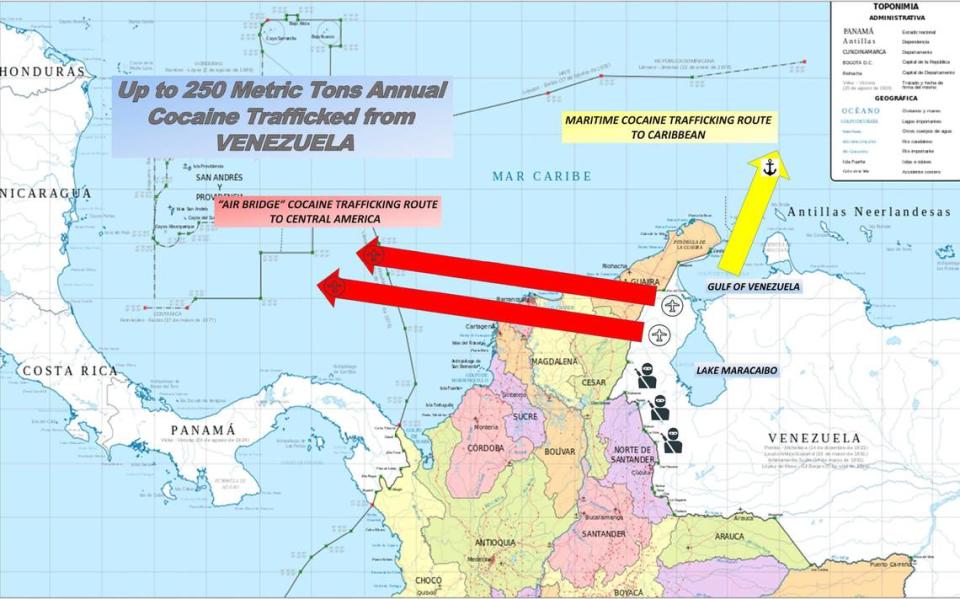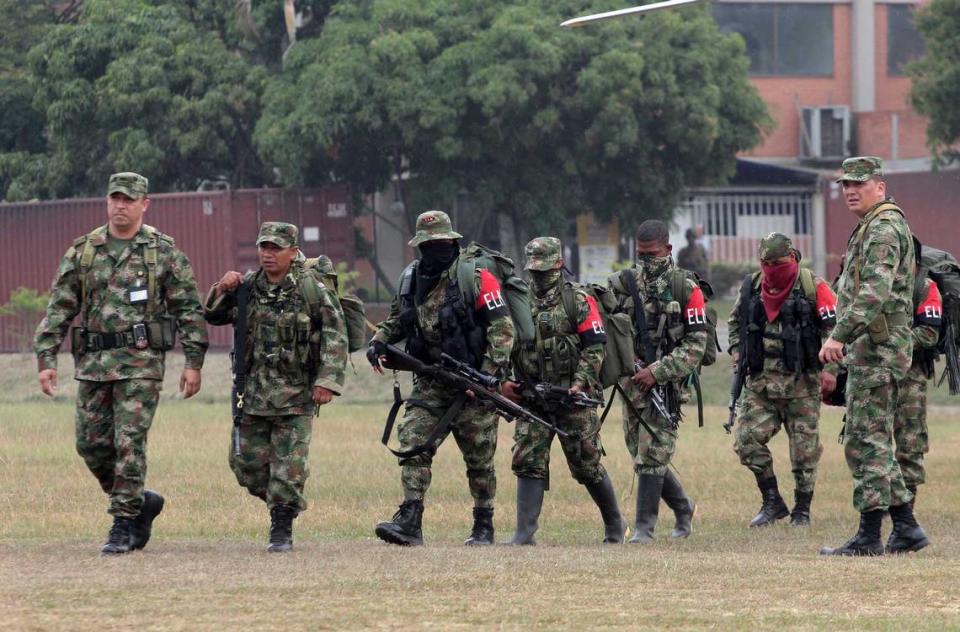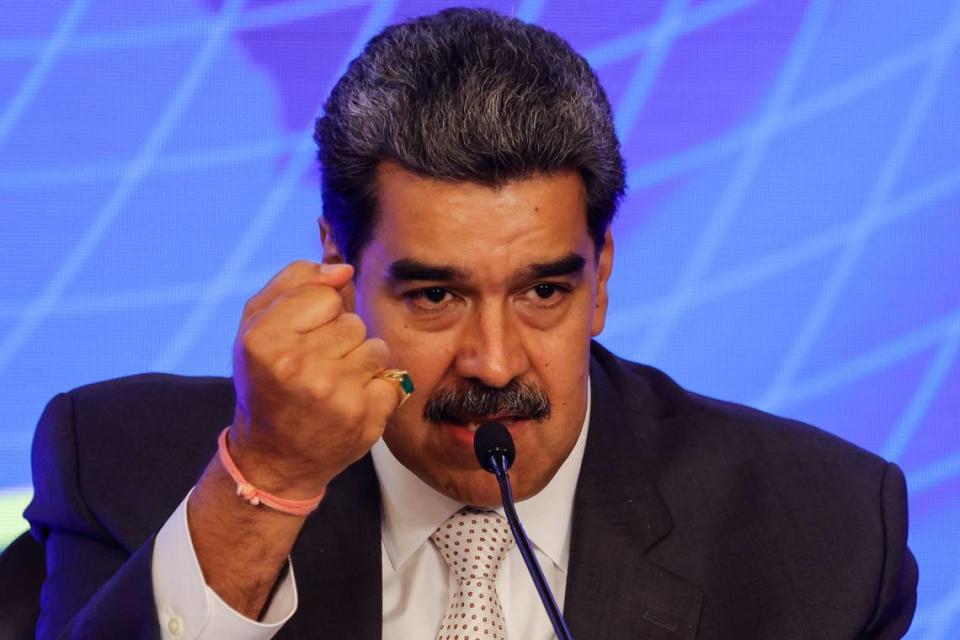Huge cyber leak offers new proof of how Maduro has turned Venezuela into a narco-state
- Oops!Something went wrong.Please try again later.
A massive leak of confidential Colombian records adds to the mounting evidence that Venezuela’s military and government elite, not content with plundering the nation’s oil wealth, are now increasingly focused on milking a different profit center: Cocaine.
The role of the military in relation to the drug trade has shifted from looking the other way in exchange for taking bribes to one of active player, according to leaked documents obtained by the Herald and its reporting partners, bolstered by interviews with former members of the Caracas regime, U.S. officials and others.
“They are the ones that are in charge now, directly involved in the transportation of cocaine, the distribution of cocaine, not only to the United States, but also to Europe,” Mike Vigil, former chief of International Operations for the Drug Enforcement Administration, said of the Venezuelan military.
This reality is part of the backdrop to what could conceivably be a thaw in frigid relations between the United States and Venezuela.
READ MORE: Explore the NarcoFiles project
In hopes of fostering stability in Venezuela, the Biden administration this past month offered an easing of sanctions contingent on President Nicolás Maduro holding free and fair elections, which for him would be a first. The initiative comes after a year in which Venezuelans, driven by social and economic upheaval, have poured into the United States, seeking asylum after making a long trek over land and across the Rio Grande. The influx has strained immigration and social services.
How Miami, a major destination for Venezuelan gold, is helping prop up Maduro’s regime
Biden’s move has outraged some Republicans, including Florida Sen. Marco Rubio, who called it “granting legitimacy to a criminal dictatorship.”
This article is being published in conjunction with the “NarcoFiles: The New Criminal Order,” a transnational journalistic investigation into global organized crime, its innovations, its tentacles, and those who fight it.
The project, led by the Organized Crime and Corruption Reporting Project in partnership with Centro Latinoamericano de Investigación Periodística, began with a massive leak of documents from the Colombian Prosecutor’s Office. The leak was shared with the Miami Herald and 40 other media outlets around the world.
Reporters sifted through the trove of documents, corroborating information through interviews and other independent reporting.

The leak and interviews painted a portrait of Venezuela’s leaders, struggling under the weight of a collapsing oil industry and the yoke of U.S. sanctions, becoming increasingly dependent on the drug trade. For top members of the government and military, this has meant forging an alliance of convenience with leftist Colombian guerrillas and other armed groups.
The result: Venezuela is now a major cocaine transport hub, shipping between 250 and 350 metric tons per year, with a street value of between $6.25 billion and $8.75 billion, much of it bound for the United States.
What began as a revolutionary movement became a government running a cartel. Or a cartel running a government.
The trend has not gone unnoticed in Washington. Three years ago, the Department of Justice filed charges against top Maduro regime officials, accusing them of heading up the Cartel de Los Soles (Cartel of the Suns), so-named because of the sun insignia worn by Venezuelan generals.
But some harbored suspicions that the charges, which have not led to arrests of those at the very top, were done for political effect, especially given that the administration of President Donald Trump had rejected Maduro’s legitimacy, instead recognizing opposition leader Juan Guaidó.
The documents included in the Colombian leak, along with other corroborating evidence, could help dispel concerns that the charges were unjustified.
“The Cartel de los Soles is a significant drug-trafficking, highly criminalized, trust-based organization operating from the most senior levels of the Venezuelan government,” IBI Consultants, a security consulting firm specializing in transnational organized crime in Latin America, wrote in a confidential report that was developed for a U.S. law enforcement agency.
According to internal reports obtained as part of the NarcoFiles, Colombian security officials consider the Cartel of the Suns an “active threat” alongside Mexico’s Sinaloa and Jalisco Nueva Generación cartels and a homegrown Venezuelan criminal organization known as El Tren de Aragua.
In one of the confidential reports, Colombian intelligence officers state that the Cartel of the Suns is active along the border departments of Vichada, Guainía and Arauca, where it established alliances with both Colombian armed rebels and Mexican cartels to establish and strengthen shipping routes for U.S.- and European-bound drugs, along with illicit gold and other illegally extracted minerals.

These alliances established a platform for a booming illegal economy, states a top-secret report produced by the Colombian army and obtained through the NarcoFiles. The platform is “used for the movement of contraband, arms trafficking and liquids required for the production of narcotics to later be taken to Venezuela and from there distributed to Central America [on its way to the United States] and Europe,” the report says.
The epicenter of this vast network is the mountainous Catatumbo region, at the border with Venezuela’s Zulia state, which has the third-largest concentration of coca-leaf plantations in the country. Sources said that the vast majority, if not the entirety of the 42,000 hectares (nearly 104,000 acres) of coca leaves planted there are turned into coca paste and later destined for Venezuela via a series of rivers.
While coca leaf eradication traditionally has been a key element of Colombia’s war on drugs, there has been a strategic shift. Under the administration of leftist President Gustavo Petro, elected in 2022, Colombia has turned its focus to chasing top members of drug-trafficking organizations.
This has led to an increase in acreage devoted to coca production, DEA sources told the Herald. Each hectare (equivalent to 2.47 acres) of harvested coca leaves has an average yield of 7.9 kilograms of powdered cocaine, according to figures provided by a report on Colombia just released by the United Nations Office on Drugs and Crime.
Those numbers suggest that more than 330 tons transited through Zulia state out of the Catatumbo region last year alone, a startling number given that experts say Catatumbo supplies only about 60% of the drugs entering Venezuela. The rest moves through the lowlands of the Arauca River and the southern jungle region through the Orinoco and Vichada rivers.
Catatumbo plantations, mostly run by independent peasants tending small lots, have become big money makers for leftist groups, namely the National Liberation Army (ELN), dissident members of the Revolutionary Armed Forces of Colombia (FARC) and the People’s Liberation Army (EPL), according to a leaked report from the Colombian army.

These groups have turned coca leaf cultivation into one of the primary income sources in Catatumbo, earning around 25 trillion pesos (US$6.38 billion) per year, said the Colombian army report, issued in 2022.
A series of clashes between the three armed groups last year, however, changed the equation, and most of the coca leaf production is currently controlled by members of the ELN, who buy from the farmers and turn the leaves into coca paste or cocaine powder to sell to the Venezuelan cartel, sources said.
Experts say the Venezuelan regime began to ease its way into facilitating drug trafficking almost 20 years ago, but note that the last three years have seen a substantial rise in volume handled by the military.
Three former Drug Enforcement Administration agents who supervised the situation in Venezuela at different times agreed with Vigil’s assessment on the current role of the Venezuelan military and the top echelon of the Maduro regime in drug trafficking operations. That view was also confirmed by half a dozen former Venezuelan officials who broke ranks with the regime and now live in the United States.
One of the former DEA agents said that given the hierarchical structure of the armed forces, where every decision comes directly from the top, “there is no doubt that the top commanders and minister of defense, Vladimir Padrino López, are directly involved.”
Indeed, Padrino was one of the Venezuelan officials charged by the U.S. Department of Justice with drug trafficking.
He was not alone. Also indicted in the United States were 13 other high-ranking Venezuelan officials, including Maduro and Congressman Diosdado Cabello, normally considered the second most powerful figure in the regime. The list also includes former Vice President Tareck El Aissami, Interior Minister Néstor Reverol, former head of military intelligence Hugo “El Pollo” Carvajal and General Cliver Alcalá.
The filing of charges has not entirely been in vain. Carvajal was extradited to the United States from Spain earlier this year to face drug trafficking charges. Alcalá already pleaded guilty in New York to assisting the FARC but denies any involvement in trafficking.
The actual number of regime officials involved in drug operations is likely much higher than the roster of those charged would suggest. Interviews conducted by the Herald with more than a dozen military and former regime officials unveiled the names of more than 75 regime officials and business people involved in the cartel’s operations.
The majority are active or retired armed forces members, but also include local and regional officials and businessmen in the areas where the shipments are moved. Also engaged in the activity are strawmen, known in Venezuela as testaferros, who lend their names so wealth and property generated by the drug operations cannot be tracked back to the cartel members actually benefiting.
The drug trade windfall has helped the regime withstand the economic blow caused by U.S. sanctions that, along with corruption and gross mismanagement, have contributed to the collapse of the country’s oil industry.
A May 2022 report by the U.S. State Department described Venezuela as a preferred route for trafficking drugs, predominantly cocaine. Another study from the U.S. Government Accountability Office highlighted drug-exporting partnerships involving “criminal organizations, corrupt individuals in the Maduro regime, and others,” including Colombian leftist guerrillas.
The wealth generated from the drug sales, often stashed overseas or in opaque offshore corporations, has become an important source of income for the regime and the Venezuelan economy. According to a recent report from Transparencia Venezuela, and analysis firm Ecoanalítica, the South American country’s branch of Transparency International, revenues from drug trafficking amounted to $5.1 billion in 2022, or 8.5% of the nation’s GDP.
Sources inside Venezuela stress that there are three main theaters of operation through which the drugs are shipped. They are:
▪ Path No. 1: The largest operation, this one channels the production coming out of the Catatumbo region, where the coca leaves are turned into paste or powder cocaine. That product is later loaded into boats that travel into Venezuela through the Catatumbo, Zulia and Tarra rivers from Colombian towns such as Ocaña, La Gabarra and Tibú.
On the Venezuelan side, operators controlled by the Cartel of the Suns have established labs that are able to transform paste into powder, which allows for greater profits. Oftentimes, the powder is taken into airstrips built in recent years near the rivers, around the towns of Encontrados and El Cruce. Planes carrying the product fly toward the Dominican Republic, before turning sharply left en route to Honduras.
While the role of the military in this area has traditionally been one of getting paid to allow the drugs to come in, it has gradually taken more control of the operations and become suppliers for the Mexican cartels. In the Catatumbo theater, the military’s control comes out of the army garrison near the town of Casigua-El Cubo, Fuerte Motilón, which holds control of the area.
The flight path through the Caribbean, heading north or north-by-northeast before turning west, was designed to avoid the radar installations in the Colombian island of San Andres, near the Nicaraguan coast, sources said. But sources said this route has begun to change after it became known to U.S. officials, and traffickers have been experimenting with fast boats heading to Haiti and the Dominican Republic.
▪ Path No. 2: The second theater of operations is based in the Colombian and Venezuelan lowlands. A significant portion of the coca leaves harvested out of the Putumayo (133,000 acres as of 2022) and Guaviare (16,700 acres) is sent east toward the towns of Cravo Norte, Tame, Fortul y Saravena and from there to the Venezuelan state of Apure through the Arauca River.
Since the lowlands are prone to flooding during the rainy season, most of the loads are taken through this sparsely inhabited area by boats toward San Fernando, Apure’s capital, and nearby towns. Cattle ranches in the area with private landing strips and access to the rivers also are used by Venezuelan cartel members as storage hubs from which they move the shipment north.
Here the primary destination is the country’s main port: Puerto Cabello, where powder cocaine is hidden inside cargo ships heading toward Europe, the Caribbean or Central America. Sources inside Venezuela said the shipments that move through the Arauca region amount to about 30% of the total entering the country.
▪ Path No. 3: The smallest of the three theaters functions around the Vichada and Orinoco rivers. Shipments coming out of Colombia are normally taken into Isla Ratón (Mouse Island) and from there toward Puerto Ayacucho on their way north toward Delta Amacuro and Monagas states.
Most of these loads are small and transported in canoes, and amount to about a tenth of the country’s total.
While the bulk of the cocaine shipments enter Venezuela through remote and at times wild areas, sources said overarching control resides in the hands of those that hold the country’s reigns in Caracas.
“All of this is administered by the same powerful factions that have control of the state, who have turned drug trafficking into an instrument of the state in order to survive,” said Douglas Farah, president of IBI Consultants. “This is not something casual. It has become a central element allowing the regime to stay in power.”

